The Spatiotemporal Matching Relationship between Metro Networks and Urban Population from an Evolutionary Perspective: Passive Adaptation or Active Guidance?
Abstract
1. Introduction
2. Literature Review
2.1. Research Content and Index Selection
2.2. Analysis Method and Model Selection
2.3. Gaps in the Current Research
3. Materials and Methods
- Draw a map of the urban metro networks based on the initial metro layout and construct a topology diagram.
- Construct a topology connection matrix based on the network topology data in Space-L. If two nodes in the networks are connected, assign a corresponding value to the topological connection matrix of 1; otherwise, assign it as 0.
- Calculate the eigenvalues of Space-L networks and use the topological adjacency matrix to calculate the degree, betweenness, and closeness values.
3.1. Metro Topological Parameter Set
- Degree
- Betweenness
- Closeness
3.2. Spatial Autocorrelation Model
3.3. Time-Lagged Regression Model
3.4. Compositive Coordination Index
- Fitness between metro middle and population gravity center
- Fractal dimension identity between metro and population
- Direction coordination between metro and population
3.5. Coupling Coherence Model
4. Results
4.1. Spatiotemporal Evolution of Metro Networks and Urban Population
4.1.1. Metro Topology Networks
4.1.2. Urban Population
4.2. Action Relationship Verification
4.3. Spatiotemporal Evolution of Matching Relationship
4.3.1. Global Matching Relationship
- Fitness between metro middle and population gravity center
- Fractal dimension identity between metro and population
- Direction coordination between metro and population
4.3.2. Spatial Heterogeneity of Matching Relationship
5. Discussion
6. Conclusions
- The network distribution had a trend of centrifugal dispersion with Moran’s I values from 0.78 in 2011 to 0.51 in 2021, respectively. The population distribution remained highly spatially dependent with Moran’s I values greater than 0.7. There existed a specific positive time-lagged interrelationship between urban metro and population distribution in the process of urban development due to the regression coefficient being more than 0.
- Along with the increased complexity of the metro topology networks, the compositive coordination index between the metro networks and the population increased from 0.29 to 0.90. The fractal identity was 1.19 until 2021, indicating that the role of the metro networks gradually crossed from “passive adaptation” to “active guidance”.
- From 2011 to 2021, there was obvious spatial heterogeneity for matching relationships. The coupling coherence degree in the core areas increased from 0.26 in 2011 to 0.41 in 2021, while the value of the outlying areas was only 0.15 until 2021.
- In the future planning policy-making of Xi’an, differentiated spatial planning strategies were proposed for core, surrounding, and outlying areas. The planning program should abandon the sprawl expansion of metro construction.
Author Contributions
Funding
Data Availability Statement
Acknowledgments
Conflicts of Interest
References
- Manouvrier-Hanu, S.; Walbaum, R.; Gayot, C. Progress of construction of the rapid transit tunnel. Aquaculture 1998, 160, 283–303. [Google Scholar] [CrossRef]
- Li, Z.; Xia, T.; Xia, Z.; Wang, X. The impact of urban rail transit on industrial agglomeration based on the intermediary effects of factor agglomeration. Math. Probl. Eng. 2021, 2021, 6664215. [Google Scholar] [CrossRef]
- Li, W.; Yang, D. Spatial analysis logic for urban transportation based on the “shaped by flow” concept. City Traffic 2020, 18, 1–8. [Google Scholar] [CrossRef]
- Hao, S.Y.; Yan, J.W.; Teng, S.H. Rail transit construction and optimization of urban spatial structure: Experience and enlightenment from Taipei. City Plan. Rev. 2013, 37, 62–66. [Google Scholar]
- Shu, H.Q.; Shi, X.F. The effect of Tokyo metropolis circle’s railway system to urban spatial structure development. Urban Plan. Int. 2008, 23, 105–109. [Google Scholar] [CrossRef]
- Calvo, F.; Eboli, L.; Forciniti, C.; Mazzulla, G. Factors influencing trip generation on metro system in Madrid (Spain). Transp. Res. Part D-Transp. Environ. 2019, 67, 156–172. [Google Scholar] [CrossRef]
- Wang, Z.; Li, S.; Song, J. Analysis of transfer service level between rail and ground bus based on bivariate spatial autocorrelation: Taking the morning peak in Beijing as an example. J. Hunan City Univ. 2023, 32, 44–49. [Google Scholar] [CrossRef]
- Cipriani, E.; Gori, S.; Petrelli, M. Transit network design: A procedure and an application to a large urban area. Transp. Res. Part C Emerg. Technol. 2012, 20, 3–14. [Google Scholar] [CrossRef]
- Cheng, X.; Zhang, X.; Shi, C.; Liu, Y.; Ding, L. Coupling effects analysis of jobs-housing distribution and rail transit network. J. Harbin Inst. Technol. 2022, 54, 35–43. [Google Scholar] [CrossRef]
- Seaton, K.A.; Hackett, L.M. Stations, trains and small-world networks. Phys. A Stat. Mech. Its Appl. 2004, 339, 635–644. [Google Scholar] [CrossRef]
- Zhang, J.; Wang, S.; Wang, X. Comparison analysis on vulnerability of metro networks based on complex network. Phys. A Stat. Mech. Its Appl. 2018, 496, 72–78. [Google Scholar] [CrossRef]
- Li, Y. Application of Bayesian hierarchical spatiotemporal model in inter-provincial population inflow analysis. Stat. Decis. Mak. 2018, 34, 73–77. [Google Scholar] [CrossRef]
- Deville, P.; Linard, C.; Martin, S.; Gilbert, M.; Stevens, F.R.; Gaughan, A.E.; Blondel, V.D.; Tatem, A.J. Dynamic population mapping using mobile phone data. Proc. Natl. Acad. Sci. USA 2014, 111, 15888–15893. [Google Scholar] [CrossRef] [PubMed]
- Kaza, N.; Nesse, K. Characterizing the regional structure in the United States: A county-based analysis of labor market centrality. Int. Reg. Sci. Rev. 2021, 44, 560–581. [Google Scholar] [CrossRef]
- Yu, Y.; Ren, H.; Gao, X. New features of the spatial pattern evolution of China’s urban population-analysis based on 2000–2020 census data. Popul. Econ. 2022, 43, 65–79. [Google Scholar]
- Chen, T.; Pan, H. Coupling Metro network with household and employment pattern: A case study of Shanghai. J. Urban Plan. 2020, 64, 32–38. [Google Scholar] [CrossRef]
- Deng, Y.; Cai, J.; Yang, Z.; Wang, H. Analysis of traffic time reachability measurements and spatial characteristics in Beijing urban area. Acta Geogr. Sin. 2012, 6, 169–178. [Google Scholar]
- Feng, H.; Li, C.; Zhang, S. Study on coordinated development of urban spatial arrangement and trail traffic based on GIS. J. Northwest Univ. 2014, 44, 821–824. [Google Scholar] [CrossRef]
- Chen, J.; Chen, X. The research of the spatial structure network of urban agglomeration based on the development of network spatial: A case study of Guanzhong urban agglomeration. Mod. Urban Stud. 2022, 37, 111–118. [Google Scholar] [CrossRef]
- Chen, B. Rail Transit Development of the Pearl River Delta planning, obstacles and history. Urban Rail Transit 2018, 4, 13–22. [Google Scholar] [CrossRef]
- Li, Y.; Monzur, T. The spatial structure of employment in the metropolitan region of Tokyo: A scale-view. Urban Geogr. 2018, 39, 236–262. [Google Scholar] [CrossRef]
- Szeto, W.Y.; Jiang, Y.; Wong, K.I.; Solayappan, M. Reliability-based stochastic transit assignment with capacity constraints: Formulation and solution method. Transp. Res. Part C-Emerg. Technol. 2013, 35, 286–304. [Google Scholar] [CrossRef]
- Wang, C.; Hokao, K. The evolution of population distribution in metro city: A case of Fukuoka city, Japan. Sci. Geogr. Sin. 2010, 30, 516–520. [Google Scholar] [CrossRef]
- Bothe, K.; Hansen, H.K.; Winther, L. Spatial restructuring and uneven intra-urban employment growth in metro- and non-metro-served areas in Copenhagen. J. Transp. Geogr. 2018, 70, 21–30. [Google Scholar] [CrossRef]
- Irsal, R.M.; Hasibuan, H.S.; Azwar, S.A. Spatial modeling for residential optimization in dukuh atas Transit-Oriented Development (TOD) area, Jakarta, Indonesia. Sustainability 2023, 15, 530. [Google Scholar] [CrossRef]
- Jiang, B. A topological pattern of urban street networks: Universality and peculiarity. Phys. A Stat. Mech. Its Appl. 2007, 384, 647–655. [Google Scholar] [CrossRef]
- Sienkiewicz, J.; Hołyst, J.A. Statistical analysis of 22 public transport networks in Poland. Phys. Rev. E 2005, 72, 046127. [Google Scholar] [CrossRef] [PubMed]
- Du, P.; Hou, X. Spatial simulation of population in China’s coastal zone based on multi-source data. J. Geo-Inf. Sci. 2020, 22, 207–217. [Google Scholar] [CrossRef]
- Hou, Q.H.; Xing, Y.T.; Wang, D.; Liu, J.C.; Fan, X.Y.; Duan, Y.Q. Study on coupling degree of rail transit capacity and land use based on multivariate data from cloud platform. J. Cloud Comput.-Adv. Syst. Appl. 2020, 9, 4. [Google Scholar] [CrossRef]
- Wu, Z.; Ye, Z. Research on urban spatial structure based on Baidu heat map: A case study on the central city of Shanghai. Urban Plan. 2016, 40, 33–40. [Google Scholar] [CrossRef]
- Wang, Y.P.; Chen, K.M.; Ma, C.Q. Quantitative analysis of coordination between rail transit network configuration and urban form. J. Railw. Eng. Soc. 2008, 11, 11–15. [Google Scholar] [CrossRef]
- Ji, Y.; Jiang, H.M. Spatial and temporal differences and influencing factors of the adaptation degree of aging and pension resources in the new era. Sci. Geogr. Sin. 2022, 42, 851–862. [Google Scholar] [CrossRef]
- Shi, D.H.; Fu, M.C. How does rail transit affect the spatial differentiation of urban residential prices? A case study of Beijing subway. Land 2022, 11, 1729. [Google Scholar] [CrossRef]
- Liu, J.M.; Hou, X.H.; Xia, C.Y.; Kang, X.; Zhou, Y.J. Examining the spatial coordination between metrorail accessibility and urban spatial form in the context of big data. Land 2021, 10, 580. [Google Scholar] [CrossRef]
- Mu, G.; Tan, S. Studies of urban geomorphology and the urban landforms in plain region. J. Southwest Teach. Univ. 1990, 34, 470–477. [Google Scholar] [CrossRef]
- Zhang, L.; Zhu, M.; Yang, W.C.; Dong, D. Modeling and analysis of network topological characteristics of urban rail transit. Urban Mass Transit 2015, 18, 28–31. [Google Scholar] [CrossRef]
- Meng, Y.; Tian, X.; Li, Z.; Zhou, W.; Zhou, Z.; Zhong, M. Comparison analysis on complex topological network models of urban rail transit: A case study of Shenzhen Metro in China. Phys. A 2020, 559, 125031. [Google Scholar] [CrossRef]
- Pang, L.; Ren, L.J.; Yun, Y.X. Research on interactive development of rail transit and spatial structure of London metropolitan circle from the perspective of complex system. J. Hum. Settl. West China 2022, 37, 98–105. [Google Scholar] [CrossRef]
- Li, C.; Ma, R.; Wang, Y.; Wang, Z. Characteristics and structure analysis of urban slow mode traffic network. J. Traffic Transp. Eng. 2011, 11, 72–78. [Google Scholar] [CrossRef]
- Zhan, X.; Lin, A.W.; Sun, C. Centrality of public transportation network and its coupling with bank branches distribution in Wuhan City. Prog. Geogr. 2016, 35, 1155–1166. [Google Scholar] [CrossRef][Green Version]
- Kumari, M.; Sarma, K.; Sharma, R. Using Moran’s I and GIS to study the spatial pattern of land surface temperature in relation to land use/cover around a thermal power plant in Singrauli district, Madhya Pradesh, India. Remote Sens. Appl. Soc. Environ. 2019, 15, 100239. [Google Scholar] [CrossRef]
- Wang, Y.Q.; Shao, M.A. Spatial variability of soil physical properties in a region of the loess plateau of pr China subject to wind and water erosion. Land Degrad. Dev. 2013, 24, 296–304. [Google Scholar] [CrossRef]
- Zhang, R.Z. Study on the factors affecting the land price of Beijing, Tianjin and Hebei based on the multivariate cointegration lag regression model. J. Cent. China Norm. Univ. (Nat. Sci.) 2017, 51, 607–614. [Google Scholar] [CrossRef]
- Becker, T.E. Potential problems in the statistical control of variables in organizational research: A qualitative analysis with recommendations. Organ. Res. Methods 2005, 8, 274–289. [Google Scholar] [CrossRef]
- York, R. Control variables and causal inference: A question of balance. Int. J. Soc. Res. Methodol. 2018, 21, 675–684. [Google Scholar] [CrossRef]
- Chen, K.; Fan, D.; Ma, C. Calculation of urban rail transit network scale based on passenger distributing centers. J. Chang. Univ. 2009, 29, 78–81. [Google Scholar] [CrossRef]
- Guo, Q.; Wu, D.; Bao, J. Evaluation of accessibility in urban rail transit network of Beijing based on transfer efficiency index and the analyze of its cause. Econ. Geogr. 2012, 32, 38–44. [Google Scholar] [CrossRef]
- Chen, S.P. Urban rail transit network accessibility metrics and spatial characteristics analysis—Guangzhou city as an example. Geogr. Geo-Inf. Sci. 2013, 2, 113–117. [Google Scholar]
- Cao, Z. Configuration of urban commercial centers and transport centers: Evidence from Tokyo transit network and urban morphology based on the complex network analysis. Int. Urban Plan. 2020, 35, 42–53. [Google Scholar] [CrossRef]
- Cui, X.; Yu, B.; Liang, P.; Wang, L.; Zhang, L. Urban rail transit station type identification and job-housing spatial rebalancing based on passenger flow and land use: Taking Chengdu as an example. Mod. Urban Res. 2021, 36, 68–79. [Google Scholar] [CrossRef]
- Niu, J.; Du, H. Coordinated development evaluation of population-land-industry in counties of western China: A case study of Shaanxi province. Sustainability 2021, 13, 1983. [Google Scholar] [CrossRef]
- Li, X.; Lu, Z.; Hou, Y.; Zhao, G.; Zhang, L. The coupling coordination degree between urbanization and air environment in the Beijing(Jing)-Tianjin(Jin)-Hebei(Ji) urban agglomeration. Ecol. Indic. 2022, 137, 108787. [Google Scholar] [CrossRef]
- Ouyang, X.; Tang, L.; Wei, X.; Li, Y. Spatial interaction between urbanization and ecosystem services in Chinese urban agglomerations. Land Use Policy 2021, 109, 105587. [Google Scholar] [CrossRef]
- Zhu, Y.; Yang, S.; Yin, S.; Cai, A. Process of change of the spatial polarization of population urbanization in the Yangtze River Delta region. Prog. Geogr. 2022, 41, 2218–2230. [Google Scholar] [CrossRef]
- Gu, J.; Zhang, H.; Chen, J.; Ren, Y.; Guo, L. Analysis of land use spatial autocorrelation patterns based on DEM data. Trans. Chin. Soc. Agric. Eng. (Trans. CSAE) 2012, 28, 216–222. [Google Scholar] [CrossRef]
- Higgins, C.; Kanaroglou, P. Rapid transit, transit-oriented development, and the contextual sensitivity of land value uplift in Toronto. Urban Stud. 2017, 55, 2197–2225. [Google Scholar] [CrossRef]

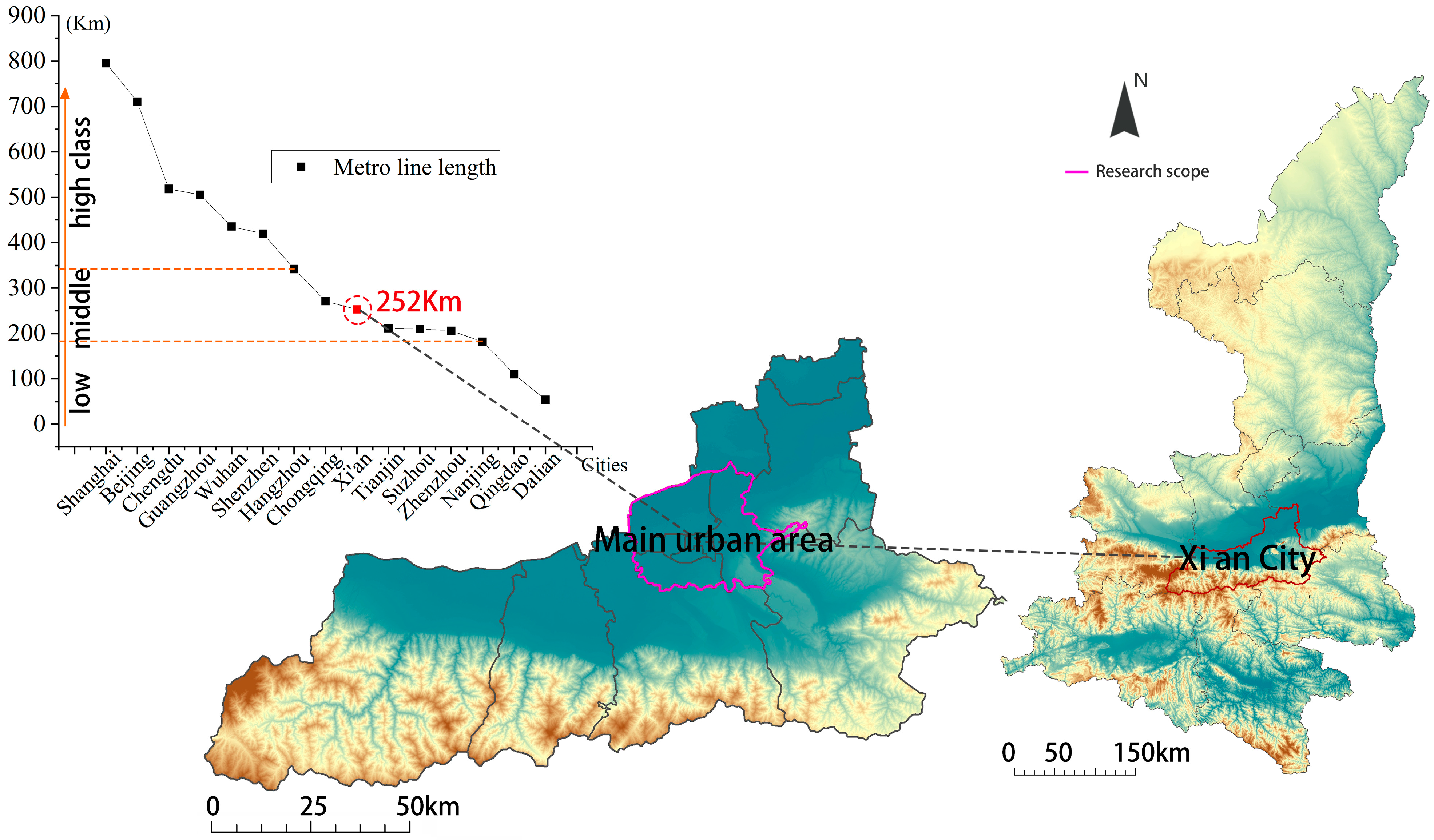

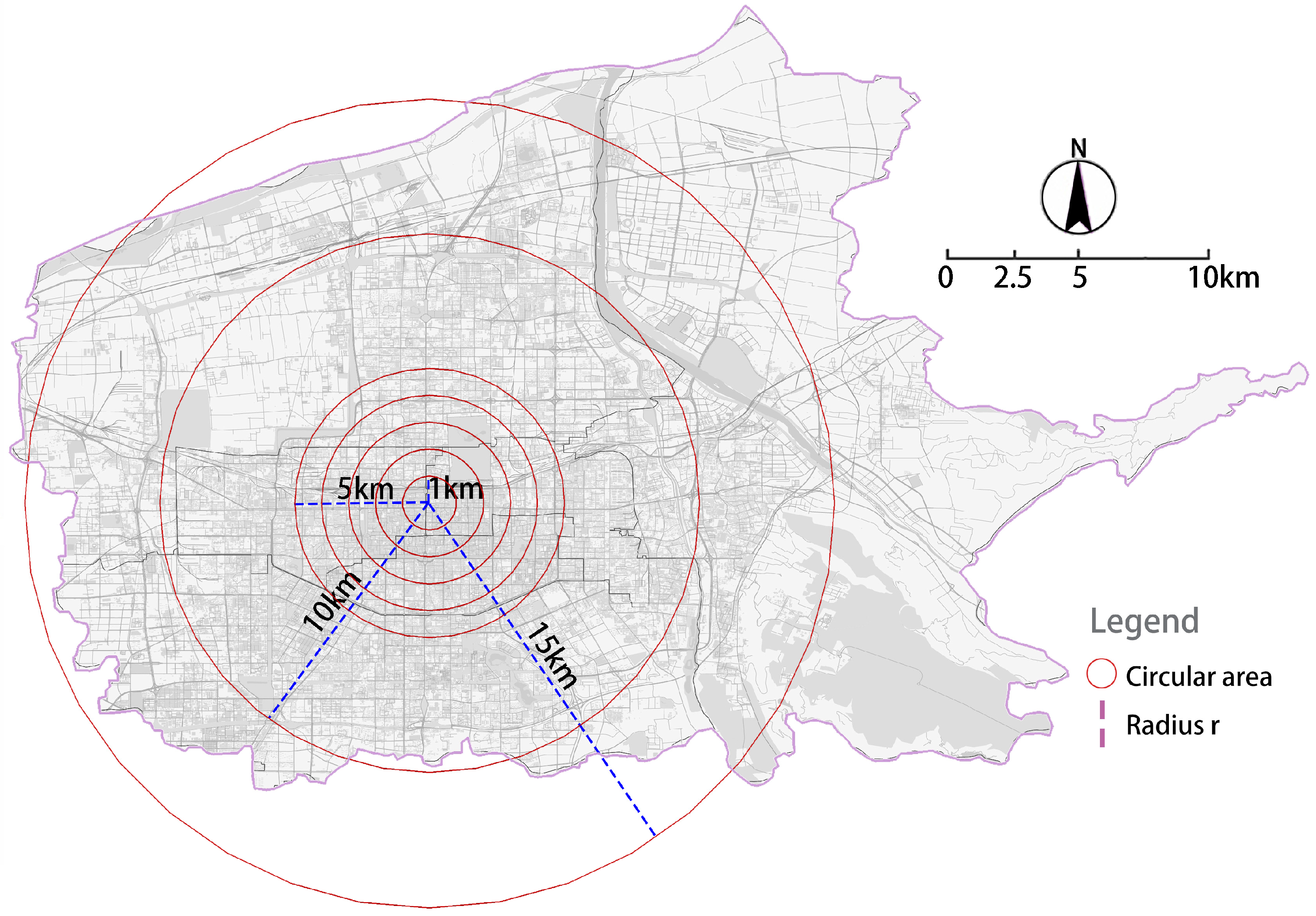
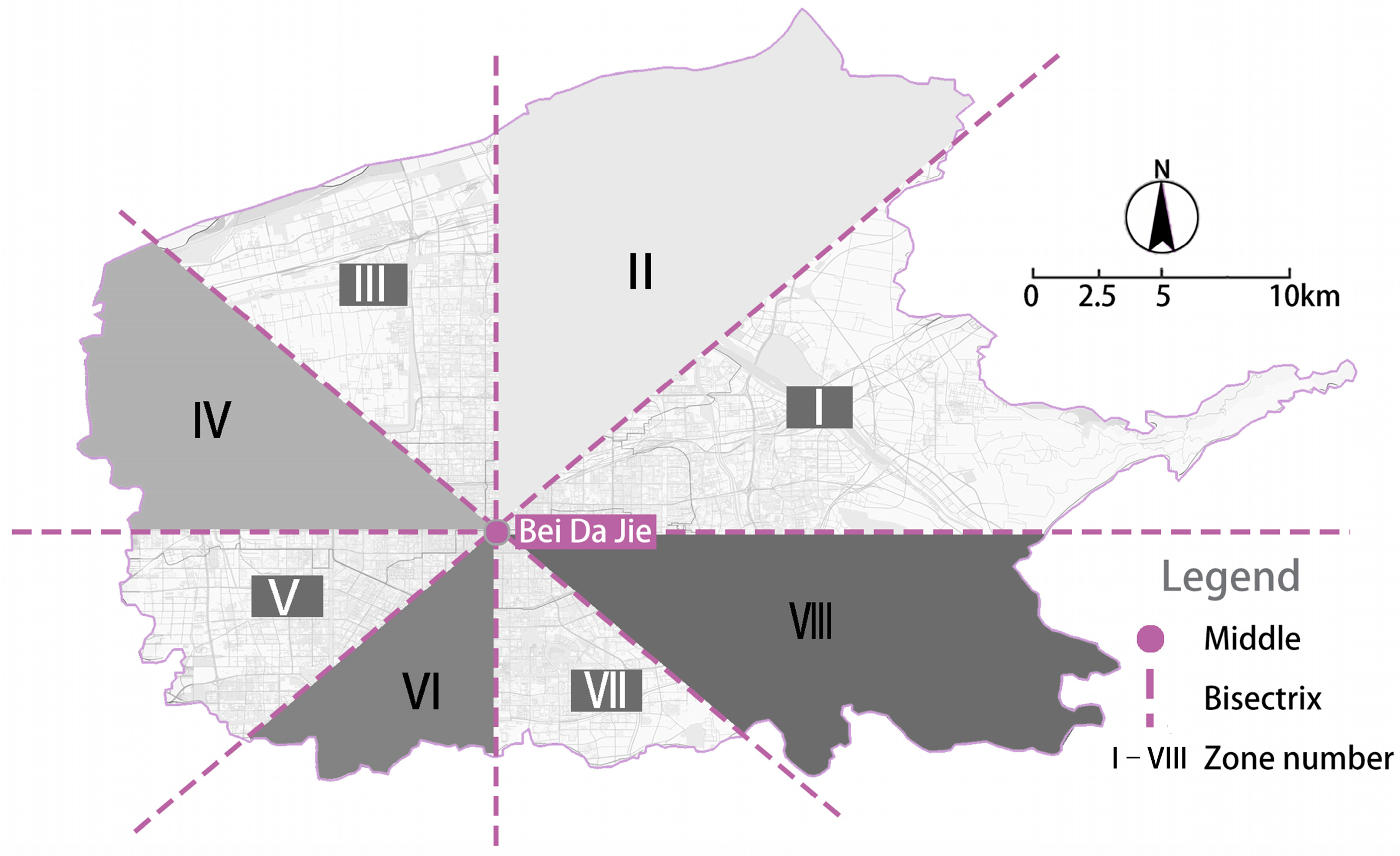


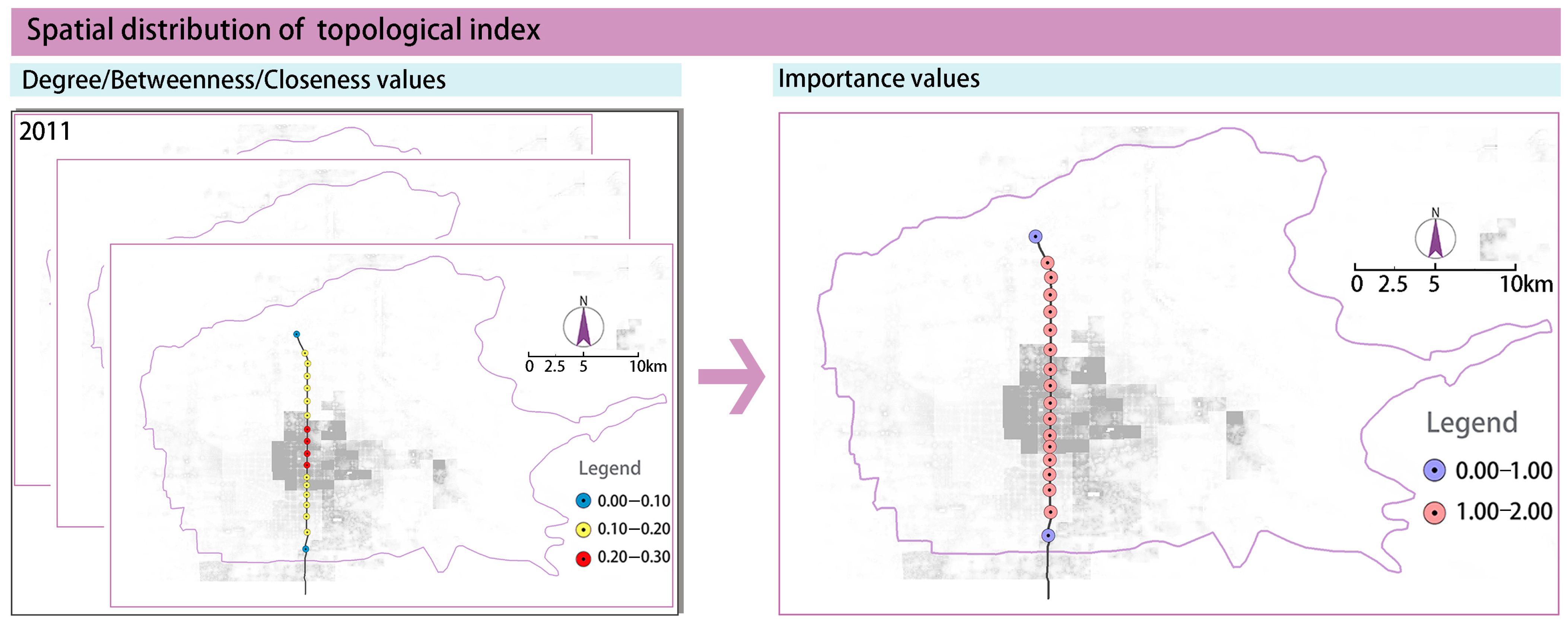
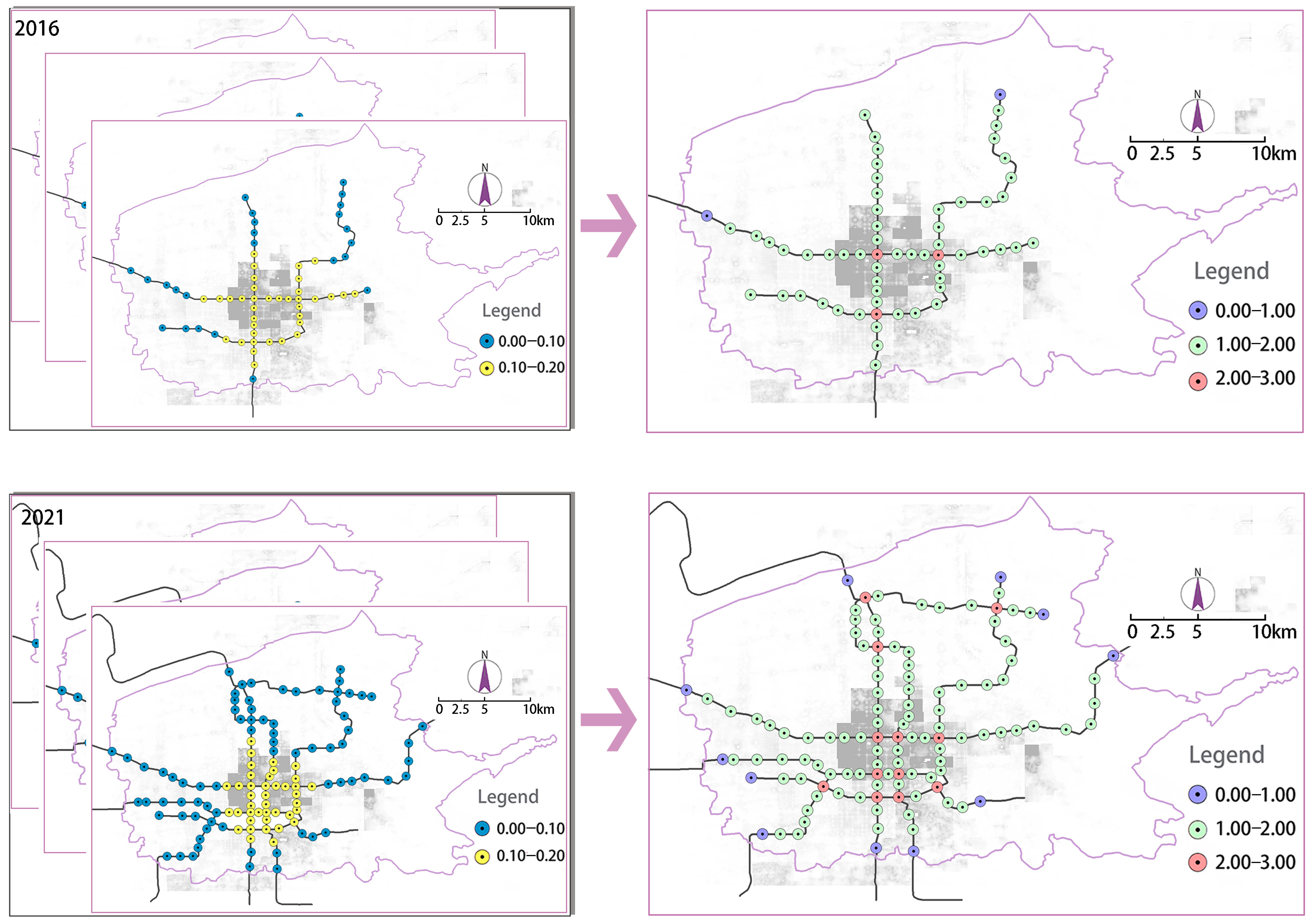



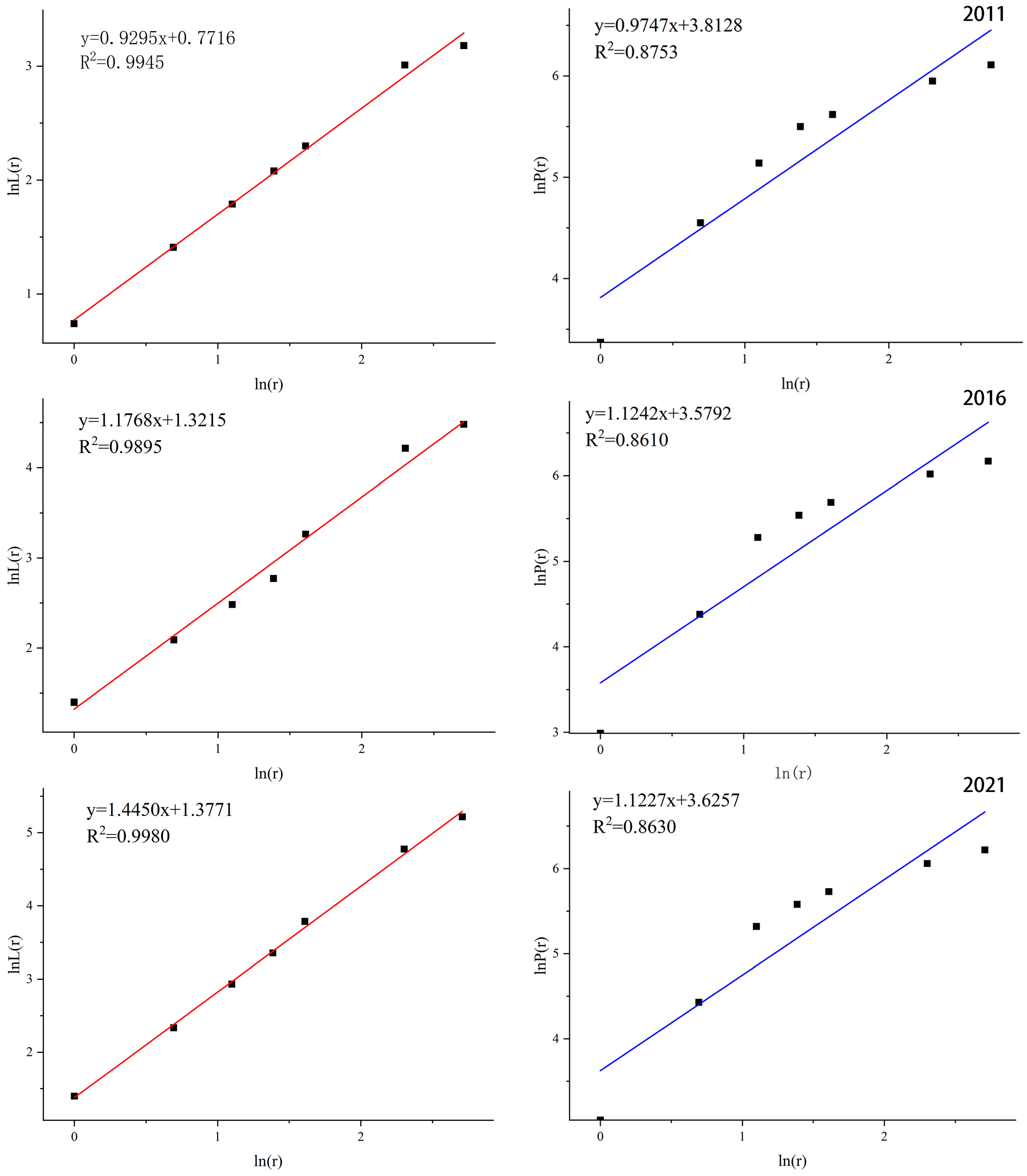

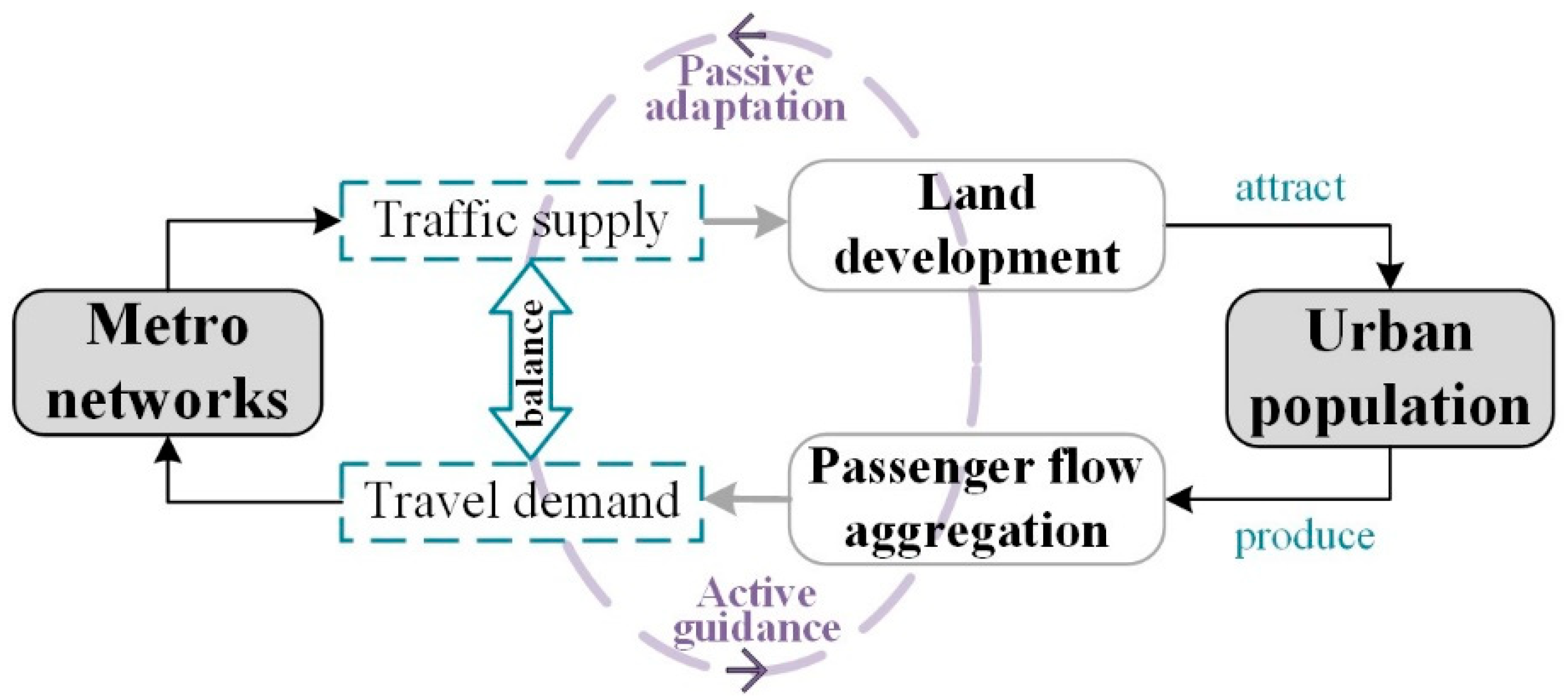
| Research Object | Indexes | Analysis Methods |
|---|---|---|
| Metro networks | Degree | Space-L complex networks |
| Betweenness | ||
| Closeness | ||
| Moran’s I value | Spatial autocorrelation | |
| Urban population | Permanent population density | Spatial quantization |
| Moran’s I value | Spatial autocorrelation | |
| Action relationship verification | Regression coefficient | Time-lagged regression |
| Spatial matching relationship | Compositive coordination index | Fitness between metro network middle and population center (W) |
| ) | ||
| ) | ||
| Coupling coherence degree (D) | Coupling coherence |
| Year | 2011 | 2012 | 2013 | 2014 | 2015 | 2016 | 2017 | 2018 | 2019 | 2020 | 2021 |
|---|---|---|---|---|---|---|---|---|---|---|---|
| Value | 0.782 *** | 0.782 *** | 0.459 *** | 0.459 *** | 0.459 *** | 0.800 *** | 0.800 *** | 0.391 *** | 0.274 *** | 0.510 *** | 0.510 *** |
| Year | 2011 | 2012 | 2013 | 2014 | 2015 | 2016 | 2017 | 2018 | 2019 | 2020 | 2021 |
|---|---|---|---|---|---|---|---|---|---|---|---|
| Value | 0.759 *** | 0.737 *** | 0.741 *** | 0.745 *** | 0.741 *** | 0.742 *** | 0.740 *** | 0.742 *** | 0.742 *** | 0.742 *** | 0.742 *** |
| Variable | Current Period | Lag Order 1 | 2 | 3 |
|---|---|---|---|---|
| Population | 0.614 ** | 1.301 ** | 1.508 ** | 0.802 |
| (5.40) | (6.76) | (3.85) | (0.68) | |
| LFR | 107.570 * | 100.600 | 104.982 | −253.900 |
| (2.44) | (1.86) | (0.79) | (0.81) | |
| Constant | −1695.39 | −1856.75 | −1983.13 | 3543.74 |
| (2.67) | (2.35) | (0.98) | (0.72) | |
| R-squared | 0.82 | 0.87 | 0.74 | 0.53 |
| Year | Coordinates of the Population Center | Distance (km) | Fitness Values |
|---|---|---|---|
| 2011 | (108.950, 34.265) | 1.02 | 0.937 |
| 2016 | (108.955, 34.265) | 1.40 | 0.914 |
| 2021 | (108.952, 34.264) | 1.18 | 0.927 |
| Time | Permanent Population | Metro Networks |
|---|---|---|
| 2011 | ||
| 2016 | ||
| 2021 |
Disclaimer/Publisher’s Note: The statements, opinions and data contained in all publications are solely those of the individual author(s) and contributor(s) and not of MDPI and/or the editor(s). MDPI and/or the editor(s) disclaim responsibility for any injury to people or property resulting from any ideas, methods, instructions or products referred to in the content. |
© 2024 by the authors. Licensee MDPI, Basel, Switzerland. This article is an open access article distributed under the terms and conditions of the Creative Commons Attribution (CC BY) license (https://creativecommons.org/licenses/by/4.0/).
Share and Cite
Lei, K.; Hou, Q.; Duan, Y.; Xi, Y.; Chen, S.; Miao, Y.; Tong, H.; Hu, Z. The Spatiotemporal Matching Relationship between Metro Networks and Urban Population from an Evolutionary Perspective: Passive Adaptation or Active Guidance? Land 2024, 13, 1200. https://doi.org/10.3390/land13081200
Lei K, Hou Q, Duan Y, Xi Y, Chen S, Miao Y, Tong H, Hu Z. The Spatiotemporal Matching Relationship between Metro Networks and Urban Population from an Evolutionary Perspective: Passive Adaptation or Active Guidance? Land. 2024; 13(8):1200. https://doi.org/10.3390/land13081200
Chicago/Turabian StyleLei, Kexin, Quanhua Hou, Yaqiong Duan, Yafei Xi, Su Chen, Yitong Miao, Haiyan Tong, and Ziye Hu. 2024. "The Spatiotemporal Matching Relationship between Metro Networks and Urban Population from an Evolutionary Perspective: Passive Adaptation or Active Guidance?" Land 13, no. 8: 1200. https://doi.org/10.3390/land13081200
APA StyleLei, K., Hou, Q., Duan, Y., Xi, Y., Chen, S., Miao, Y., Tong, H., & Hu, Z. (2024). The Spatiotemporal Matching Relationship between Metro Networks and Urban Population from an Evolutionary Perspective: Passive Adaptation or Active Guidance? Land, 13(8), 1200. https://doi.org/10.3390/land13081200








